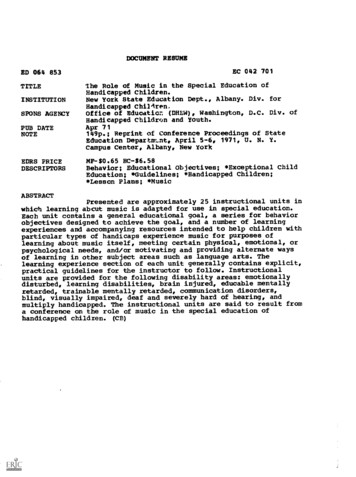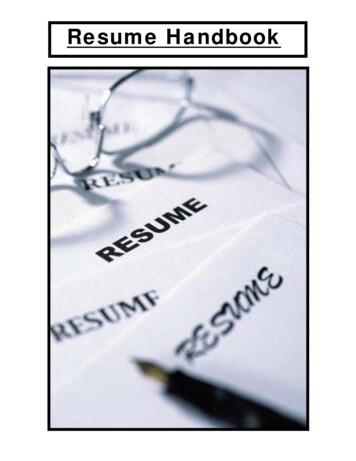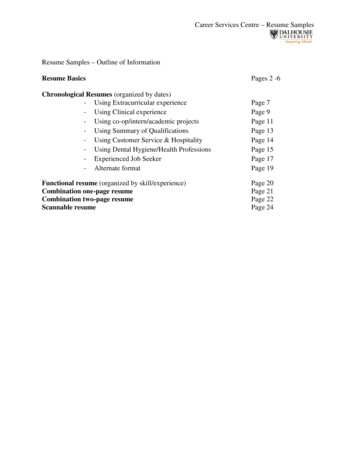
Transcription
DOCUMENT RESUMEEC 042 701ED 064 853TITLEINSTITUTIONSPONS AGENCYPUB DATENOTEEDRS PRICEDESCRIPTORSThe Role of Music in the Special Education ofHandicapped Children.New York State Education Dept., Albany. Div. forHandicapped Chiliren.Office of Education (DHEW), Washington, D.C. Div. ofHandicapped Children and Youth.Apr 71149p.; Reprint of Conference Proceedings of StateEducation Departmnt, April 5-6, 1971, U. N. Y.Campus Center, Albany, New YorkMF6- 0.65 HC-S6.58Behavior; Educational Objectives; *Exceptional ChildEducation; *Guidelines; *Handicapped Children;*Lesson Plans; *MusicABSTRACTPresented are approximately 25 instructional units inwhich learning abcut music is adapted for use in special education.Each unit contains a general educational goal, a series for behaviorobjectives designed to achieve the goal, and a number of learningexperiences and accompanying resources intended to help children withparticular types of handicaps experience music for purposes oflearning about music itself, meeting certain physical, emotional, orpsychological needs, and/or motivating and providing alternate waysof learning in other subject areas such as language arts. Thelearning experience section of each unit generally contains explicit,practical guidelines for the instructor to follow. Instructionalunits are provided for the following disability areas: emotionallydisturbed, learning disabilities, brain injured, educable mentallyretarded, trainable mentally retarded, communication disorders,blind, visually impaired, deaf and severely hard of hearing, andmultiply handicapped. The instructional units are said to result froma conference on the role of music in the special education ofhandicapped children. (CB)
6he 1o1e 01oeeio,.0neeuee 17i1(Vel40THE UNIVERSITY OF THE STATE OF NEW YORK / THE STATE EDUCATION DEPARTM1DIVISION FOR HANDICAPPED CHILDREN- DIVISION OF THE HUMANITIES AND THE/ALBANY, NEW YORK 12224
ik)P4p,adj1 Ie.),614CIO16'1 *".1"1"1101?4,RSITY OF THE STATE OF NEW YORK / THE STATE EDUCATION DEPARTMENTOR HANDICAPPED CHILDREN- DIVISION OF THE HUMANITIES AND THE ARTSALBANY, NEW YORK 12224
CONFERENCE,PLANNING COMMITTEEVivienne N. AndersonDirector, Division of the Humanities and the Arts, State Education Department, Albany, New YorkRaphael F. SimchesAssistant Diector, Division for Handicapped Children, State Education Department, Albany, New Yor7Zelda KayeChief, Bureau of Special Programs for the Handicapped, State Education Department, Albany, New Yor'A. Theodore TellstromChief, Bureau of Music Education, State Education Department, Albany, New YorkNathan GottschalkChairman, Music Department, State University of New York at AlbanyJohn A. QuatraroAssociate, Bureau of Music Education, State Education Department, Albany, New YorkRita A. SatorAssociate, Bureau of Secondary Curriculum Development, State Education Department, Albany, New Yor7Sona NoceraAssociate FroPssor, Crane Department of Wsic, State University of New York at PotsdamPROJECT DIRECTORRichard FeldmanEhOish Teacher, Bethlehem Central High School, Delmar, New York3
Ehe fo1eTaZiefin the 8 eoiue0Chil 0 per?April 5 & 6,Special StudieThoTHEDivDivisi
teeoeeio1floiQo ooere'?U.S. DEPARTMENT OF HEALTH,EDUCATION & WELFAREOFFICE OF EDUCATIONTHIS DOCUMENT HAS SEEN REPRODUCED EXACTLY Ats RECEIVED FROMTHE PERSON OR ORGANIZATION ORIGINATING IT. POINTS OF VIEW OR OPIN-IONS STATED DO NOT NECESSARILYREPRESENT OFFICIAL OFFICE OF EDUCATION POSITION OR POLICY.April 5 & 6, 1971.5. U. N. Y.Campus CenterAlbany, New YorkSpecial Studies Institute Funded Through Section 301 P.L. 85.926, as amended U.S. Office of EducationThe University of the State of New YorkTHE STATE EDUCATION DEPARTMENTDivision for Handicapped ChildrenDivision of the Humanities and the Arts
We are not simply in the business of teaching music formusic's sake; we are using music as a tool, as a catalyst,as a heZping agent.A music program can, in fadt, facilitate and contributeto the totaZ Zearning, the total adjustment, the totaZhabilitation of the child.Kenneth MedemaDirector of Music and Creative Art TherapiesEssex County Hospital Center
Monday, April 5, 19718:309:30 a.m.Registration and Sign:.up for "How-To-Sessions" .Main LoungeConference Host --Dr. Nathan Gottschalk, Chairnan, Music Department, SUNY Albany--A continuous showing ef films relevant to special education and music is scheduled in Room 220during conference hours.The Special Education Instructional Materials Center, Room 120, 55 Elk Street, will hold anopen house on both days of the conference, from 8:30 a.m. to 4:30 p.m.--Commercial exhibits --displayed during conference hours --Lounge9:30 a.m.Conference Opening Session --BallroomWelcome -.Dr. A. Theodore Tellstrom Chief, Bureau of Music EducationConference Overview --John A. Quatraro, Associate, Bureau of Music EducationIntroduction of Speaker --Dr. Zelda Kaye, Chief, Bureau of Special Programs for the HandicappedOpening Address -:"Perspectives on the Education of Children with Special Needs"DT. Burton Blatt, Director, Division of Special Education and Rehabilitation, Syracuse University10:45 -- 12:00 NoonSession IVISUALLY IMPAIRED --Room 315"Music Resources for the Blind"Mary Mylecraine, Music Reference Librarian, Division for the Blind and Physically Handicapped,United States Library of Congress, Washington, D. C."Recorded Aid for Braille Music"Kenneth Medema, Director of Mnsic and Creative ATt Therapies, Essex County Hospital Center,Cedar Grove, New JerseyChairman:Charles J. Trupia, Associate, Bureau of Music EducationMENTALLY RETARDEDBallroom"Music Can Teach the Exceptional Child"iii
Drs. Herbert and Gail Levin, Music Specialists for Special Education, with a studentdemonstration group from Albany-Schenectady-Schoharie Counties BOCESChairman:Eugene J. Cunningham, Associate, Bureau of Music EducationEMOTIONALLY HANDICAPPED --Assembly Hall"Music Means Movement --Creative Rhythms and Dance in Special Education"Mrs. Elizabeth Polk, Dance Therapist, Long Island City, New YorkChairman: Sona Nocera, Associate Professor, Crane Department of Music, State University College,Potsdam, New York12:001:30 p.m.LunchDutch 'Treat in Patroon Room or Cafeteria --Campus CenterChairman:Richard Feldman, Project Director1:30 2:45 p.m.Session IIEMOTIONALLY HANDICAPPED .Assembly Hall--"Group Activities in Music for the Emotionally Handicapped Child"Mrs. Grace Nash, Music Specialist, Consultant and Publisher, Scottsdale, ArizonaChairman:Charles Matkowski, Supervisor, Division for Handicapped ChildrenHEARING IMPAIRED .Room 315--"Rhythmics Program for the Deaf"Sister Rose Marie Brick, St. Mary's School for the Deaf, Buffalo, New YorkChairman:MENTALLY RETAPnEDBebe Bernstein, Supervisor, Bureau for Children with Retarded Mental Development, New York CiBallroom--"Practical Applications of Music for the Development of Learning Abilities and Basic Communication Skillsin Childrin with Mental, Physical, and Emotional Deviations"Dr. Richard Weber, Professor of Music, Trenton State College, Trenton, New Jersey, with a studentdemonstration group from Albany-Schenectady-Schoharie Counties BOCESChairman:2:45Conrad Hecht, Director of Special Education, Massapequa Public Schools, Massapequa, New York4:00 p.m.Session IIIiv
"How-To-Sussions" An exchange of ideas. Small group sessions designed to develop instructional units formusic in special education. Special interest group sign-up during registration.4:00 7:30 p.m.Leisure Time and Dinner8:00 p.m.BallroomSession IVMusical Program and DemonstrationClinic ConcertStudents from the New York State School for the Blind at Batavia --John E. Grapka, Director of Music;Muriel K. Mooney, Henry A. Emmans, and Janet D. Fryling, Instructors--"Androcles and the Lion," by Aurand Harris (adapted by Dorothy Dodd)Students from St. Francis de Sales School for the Deaf in Brooklyn, directed by Dr. Dorothy Dodd,with the assistance of Sister Mary Cleary and Sister Mary Ann RobertsonChairman:Richard Feldman, Project DirectorTuesday, April 69 19719:15 10:30 a.m.Session VVISUALLY IMPAIRED-- Room 315"Braille Music Reading"Mrs. Muriel K. Mooney, Instructor of Music, New York State School for the Brnd, Batavia, New York,with a student demonstration group from the New York State School for the Blind at BataviaChairman:MENTALLY RETARDEDSamuel Bozzella, Supervisor of Music, Bethlehem Central Schools, Delmar, New YorkBallroom"The Adaptability of Conventional Instructional Approaches in Music to Special Education Needs"Mrs. Alleen L. Fraser, Rochester City School District, Rochester, New YorkChairman:Priscilla Ehrlich, Advisor, Education Development Center, Newton, MassachusettsHEARING IMPAIRED -.Assembly Room--"Programs in Dance and Choral Recitation for the Deaf"Mrs. Blanche D. Baldwin, Teacher of SpelcA and Rhythm, and Mrs. Beverly Sacco, Teacher of Rhythm andAccompanist, Rochester School for the Deaf, Rochester, New York, with a student demonstration group
from the Rochester School for the DeafChairman:Leonard Zwick, Principal, Rochester School for the Deaf10:30 11:45 a.m.Session VISEVERELY MULTIPLE HANDICAPPED --Assembly Hall"Musical Experiences for the Severely Multiple Handicapped Child"Carol A. Matteson, Music Therapist, School of Special Education, Crotched Mountain Rehabilitation Center,Greenfield, New HampshireChairman:Robert Fischer, Project Director, SEIMC for Rockland County, New YorkEMOTIONALLY DISTURBED AND BRAIN INJURED Ballroom"Music Makes Me Move -.Reaching the Emotionally Disturbed and Brain Injured Child"Ruth Christiansen, BOCES, Third Supervisory District of Suffolk County, Dix Hills, New York, with astudent demonstration group from BOCES, Third Supervisory District of Suffolk CountyChairman:Theodore Kurtz, Associate, Division for Handicapped ChildrenCOMMUNICATION DISORDERS Room 315"Music as Therapy for Children with Communication Disorders"Mrs. Theoda Vera Moretti, Music Therapist and Director of Music, W.E. Fernald State School,Waverly, MassachusettsChairman: Mary English, Professor of Music and Coordinator of Vocal Music Education, StateUniversity College at Potsdam11:451:15 p.m.Lunch -.Dutch Treat in Patroon Room or Cafeteria --Campus CenterChairman:1:15Richard Feldman, Project Director2:30 p.m.Concluding Session --Ballroom--"Music in Special Education" --An OverviewDialogue -.Conference Consultants wlth Audience ReactionModerctor --Sona Nocera, Associate Professor of Music, State University College, Potsdam, New YorkChairman:John A. Quatraro, Associate, Bureau of Music Educationvi
ForewordOne of the chief characteristics of education in New York State has been the effort to guarantee to every child theopportunity for an education of the highest quality that will enable him to become "all he is capable of being."The aim is noble, but its ill realization --especially for the handicapped child --has yet to be achieved.To alarge extent, progress has been hindered by inadequate preparation of teachers and a dearth of readily available resources.In music, for example, relatively few teachers are equipped with expertise both in the subject and in the needsand capabilities of handicapped children.As a result, the special education teacher is often faced with teaching a sub-ject in which his knowledge is limited, and/or the music teacher must modify his work to accommodate learning patternsand modes of expression that are sometimes quite different from those he observes in his regular classes.The experienceis a growing one for both; but it is also difficult, and there is little by way of supportive material to help.On April 5-6, 1971, the State Education Department moved to resolve the problem.Cosponsored by the Division forHandicapped Children and the Division of the Humanities and the Arts, the first Statewide conference on The Role ofMusic in the Special Education of Handicapped Children brought together teams of music teachers and department heads,and special education teachers and administrators, to work with nationally recognized consultants in music and specialeducation.Nearly a year was spent in preparation.Each consultant was asked to develop a few instructional units ac-cording to a model designed in the Bureau of Secondary Curriculum Development and adapted for music in special educationby Associate Professor Sona Nocera of the Crane Department of Music, State University College at Potsdam, New York.Asindicated on the following pages, each of these units includes a general goal, a series of behavioral objectives designedto achieve the goal, and a number of kerning experiences and accompanying resources intended to help children with particular types of handicaps to experience music for the purpose of:Learning about music per se;Moeting specific physical, emotional, or psychological needs, and/orMotivating and providing alternative ways of learning in other subjectareas (e.g., the language arts).Every participant received a set of units for each of the meetings he attended; observed a lecture-demonstration of at
question theleast one of the items in the set (in many cases with on-the-scene student groups); had an opportunity toconsultants both during their presentations and later in special workshop sessions; and left the conference with tangiblematerials and the beginnings of a team effort to implement effective programs for music in the special education of handicapped children in his own school or district.The confersnce was conceived and developed by John A. Quatraro, Bureau of Music Education, with continued supportfrom Zelda Kaye, chief of the Bureau of Special Programs for the Handicapped, and particular assistance from Eugene J.Cunningham and Charles J. Trupia, associates in the Bureau of Mimic Education.Richard Feldman of Bethlehem CentralHigh School was the project director; and Nathan Gottschalk* chairman of the Music Department, State University of NewYork at Albany, served as host. The report of the conference proceedings was prepared for publication by Rita A. Sator,Bureau of Secondary Curriculum Development, and is available without charge from the Publications Distribution Unit,State Education Department, Albany, New York12224.Raphael F. SimchesVivienne N. AndersonAssistant Director,Director,Division for Handicapped ChildrenDivision of the Humanities and the ArtsviiiC)
6ctIDIe ot CoptentsPageCONFERENCE PROGRAMiiiFOREWORDviiTABLE OF CONTENTSixINSTRUCTIONAL UNITS FOR MUSIC IN THE SPECIAL EDUCATION OF HANDICAPPED CHILDRENEMOTIONALLY DISTURBED, LEARNING DISABILITIES, BRAIN INJUREDRuth Christiansen13BOCES, Third Supervisory District of Suffolk County, Dix Hills, New YorkEMOTIONALLY DISTURBED, LEARNING DISABILITIES9Elizabeth Polk --Dance Therapist, Long Island City, New YorkEMOTIONALLY DISTURBED19Grace Nash --Music Specialist, Consultant, and Publisher; Scottsdale, ArizonaEDUCABLE MENTALLY RETARDED, TRAINABLE MENTALLY RETARDED23Herbert and Gail Levin --Music Specialists for Special Education, Philadelphia, PennsylvaniaEDUCABLE MENTALLY RETARDED31Alleen L. Fraser --Rochester City School District, Rochester, New YorkEDUCABLE MENTALLY RETARDEDRichard Weber43Professor of Music, Trenton State College, Ttenton, New JerseyCOMMUNICATION DISORDERS47Vera MOretti -.Music Therapist and Director of Music, W. E. Fernald State School, Waverly, Massachusetts49BLINDAuriel K. Mooney Instructor of Music, New York State School for the Blind, Batavia, New Yorkix
51VISUALLY INPAIREDCounty Hospital CenterKenneth Medema --Director of Music and Creative Art Therapies, Essex59VISUALLY IMPAIREDthe Blind, Batavia, New YorkHenry A. Emmans --Instructor of Music, New York State School for61VISUALLY IMPAIREDthe Blind, Batavia, New YorkJanet D. Fryling --Instructor of Music, New York State School for63VISUALLY IMPAIREDBlind, Batavia, New YorkJohn E. Grapka --Director of Music, New York State School for the67DEAF AND SEVERELY HARD OF HEARINGNew YbrkSister Rose Marie Brick --st. Mary's School for the Deaf, Buffalo,75DEAFDeaf, Rochester, New YorkBlanche D. Baldwin --Teacher of Speech and Rhythm, Rochester School for the81MULTIPLE HANDICAPPEDEducation, Greenfield,Carol A. Matteson --Music Therapist, Crotched Mountain School of SpecialNew Hampshire87CONFERENCE EVALUATION89EVALUATION FORM91EVALUATION REPORT97CONFERENCE PARTICIPANTS/.1-
umoneiltutci!lo1%Tun eni9eIty)on(10I1oê000JoQo NOCleselesql% Ioes1
The instructional units included herein were preparedpursuant to a consultant appointment with the Division forHandicapped Children, New York State Education Department.Consultants preparing such units under Department sponsorship were encouraged to express their professional judgmentsfreely in the conduct of the conference.Points of view oropinions stated do not, therefore, necessarily represent official State Education Department position or policy.
Emotionally DisturbedLearning DisabilitiesPrimaryIntermediateBrain InjuredPrimaryIntermediateAdvancedRuth ChristiansenBOCES - Third Supervisory District ofSuffolk CountyDix Hills, New YorkGoal:Enhancement of self-imageLearning ExperienceObjectiveResourceA violin for each childThe student demonstratesa knowledge of thenames of the violinstrings.Have the"ThisThisThisThischildren sing,is Daddy G;is Mama D;is Brother A; andis Sister E."The student demonstratesthe ability to pluckthe strings of a violin.Have each child place his violin on "the shelf made just forviolinists" (the collarbone or clavicle) and then pluck eachstring four times, doubling on the E.The student demonstratescorrect bow position.Have the children memorize and sing a "bowing commercial" suchas the following:"Bend your thumb,Curve your pinky,Let your fingers fall -Chat Chat Cho:"The student demonstratesthe ability to dolegato or "smooth bow"bowing.Have the children run through open string drills. Then havethem play smooth bow on AE,creating their first double stop.Involve the children in an immediate esthetic experience byaccompanying their efforts with a piano rendition of "IrishJig.""Irish Jig"Have the children play smooth bow on one violin string. Thenplay any familiar round at the same time and they will follow.The student demonstratesthe ability to dostaccato bowing on"stop bow."Have the children play open string cycles, using "stop bow."Then have them play stop bow on the G string alone while youaccompany them on the piano with "The Syncopated Clock."Finally, teach them stop bow and tremolo on open G, accompanying their efforts with "Spook Song" on the piano.3"The Syncopated Clock""Spook Song"
ObjectiveLearninEx erienceResourceThe student demonstratesthe ability to dospiccato or "bouncybow" bowing.Have the children play open string cycles, using spiccato bowing. Then have them play "bouncybow" on the D string whileone of their classmates plays d minor third on the piano.The student demonstratesthe ability to playthe "first finger."Have the children sing "I can play my violin just as wellasteacher can," and then sing and play at the same time.The student demonstratesthe ability to play"all fingers."Have the children sing "Going up and coming down," and thensing and play simultaneously.The student demonstratesthe ability to play amajor scale.Involve Cho chjidren in a rote reading exercise such as thefollowing:EBEHAAAA2222 3333111122223333The ailegro eras Monti'sCsardde
Ruth ChristiansenBOCES - Third Supervisory District ofSuffolk CountyDix Hills, New YorkGoal:Emotionally DisturbedBrain InjuredPrimaryIntermediateLearning nt of perceptual motor skills (directionality)ObjectiveLearning Expet.*ienceResourceThe student demonstratesthe ability to maintaina basic beat by alternating left and rightstrokes.Begin basic rhythm patterns by focusing the children's attention on left and right. Make sure that they begin each patternwith a left stroke."The Bridge on the RiverKwai," "The Caisson Song,""Anchors Aweigh," and"The Marines Hymn"The student demonstratesthe ability to play"street beats."Demonstrate Street Beat #1 and ask the children to imitateyour performance.Rhythm instruments such asparade drums, bongo drums,etc. and rhythmic patternswith which the children caneasily copeDemonstrate Street Beat #2 in the same manner, and then havethe children sing a song like the following as they work ondirectional drills:"I play my drum with my right, right, right;I make a sound which is out of sight."Demonstrate Street Beat #3 in the same manner, and then havethe children play all three street beats, followed by a rolloff. A selected group of children might perform to a selectionsuch as "On Wisconsin.""On Wisconsin"The student demonstratesthe ability to imitaterhythmic patterns.Have the children listen and respond to music with differentrhythmic patterns (e.g., waltzes, marches, Latin Americandance music, jazz selections). Then have them accompany therecordings with rhythm' patterns played on a variety of musicalinstruments.Recorded music in a varietyof rhythmic patternsThe student demonstratesthe ability to createhis own rhythmicpatterns.Have the children listen to a number of songs with differentrhythm patterns and either sing or accompany them with rhythmsplayed on a variety of instruments. Then encourage them tocreate new patterns of their own.Appropriate selections such as"Tijuana Taxi," "Lemon TreeMarianne," "Swanee River,""Carolina," "Dixie," etc.
Ruth ChristiansenBOCES - Third Supervisory District ofSuffolk CountyDix Hills, New YorkDal:Emotionally DisturbedBrain InjuredLearning DisabilitiesIntermediateAdvancedEnhancement of self-imageObjectiveThe student demonstratesthe ability to play"Gyp C" and "Gyp G"chords on a guitar.Learning ExperienceUsing a 0 motion, teach each student how to strum a guitar.Then have him place one finger for the C chord pattern and playa "Gyp C" chord. Repeat the procedure for a "Gyp G7" chord.NUMResourceSelections from country andwestern music which include only the C chordtonalityMEM. EtonC chord"Gyp G7" chordThen encourage him to play selections such as "Spanish Dance"which include both the C and G chord tonalities.The student demonstratesthe ability to accompany himself on aguitar as he sings.Distribute copies of the words and music to such songs as "He'sGot the Whole World in His Hand," "Lemon Tree," or Marianne"with chord changes clearly indicated --and teach the studentsto sing and play them. Select songs that include tonic anddominant chord progressions, if possible; but remember thatexceptional children need to experience immediate results. Foradded color, one or another of the members of the class mightplay bongo drums, a tambourine, etc. to accompany the music ofthe guitars.The student demonstratesthe ability to play anauthentic G chord.Teach the students the proper techniques for playing a G chordand for reading the chord diagrams in music for a guitar. Forexample, the G chord diagram looks like this:G chordPlay as much music as possible based on the tonic chord underconsideration --in this case, G; in the next, D7. By now thestudents should readily understand how to play original melodies which include only tonic chordal tones, and some theorycan be introduced."Spanish Dance"The words and music for appropriate selections fromcalypso music, show tunes,folk music, and nonsensesongs
Ob ectiveThe student demonstratesthe ability to play aD7 chord.LearninEx erience"Camptown Races" is an excellent song to introduce the D7chard, because the chord change occurs on the words "Doo Dah"and the children seem to comprehend it immediately.Resource"Camptown Races"D7 chordThe student demonstratesthe ability to play IIV V chord progressionsusing authentic G, GypC, and D chords.Have two students play any bass line sequence they have learnedbefore, in the manner of folk guitarists playing rock chordprogressions. The students should now be able to play rock'nroll chord progressions and can move independently at theirown levels of learning.The student demonstratesthe ability to participate in a hootenanyiHelp the students to organize and present a hootenany:- Include a variety of selections and instruments,including some from Latin America.- Thoroughly familiarize the students with the wordsto all the songs.- Make sure that charts are available for the chording on all the songs, or that the students areable to rely on hand signals for chord changes.7Appropriate selections suchas "This Land Is YOUTLand," "What the WorldNeeds Now," "Sugar,""Georgie Girl," "Let theSun Shine In," etc.
Fr4.11V;t1.1.)/-ot, '--1.,b!; ;,-1'4.44 -.,z: .--,,.z.:-I.'4co,--,;',.is.1;,-,:, :.-.t.-1ka,i'',.-.,0.064.7.,.,4.-.----M111,11'' '1, -'': 41:74:-1',.,-;-4'.e -4.4!nabierimrage.,/' -:sf.
Elizabeth Polk39-48 46th StreetLong Island City, New YorkGoal:Emotionally DisturlLearning Disabilit'PrimarYImprovement of the ability to listen and to respond rhythmicallyObjectiveThe student demonstratesthe ability to produceand respond -4.o basicrhythms.Learning ExperiencePlay the "talking drum" game. With the children sitting in acircle on the floor, introduce the "talking drum." Then sayyour first name aloud and beat its rhythm on the drum.Havethe children clap their hands to your beat and repeat your nameas you "play" it. Then pass the drum to each child and havehim perform in the same manner with his own name. Encouragethe children to find different ways of responding to the rhythm(e.g., beating the floor, other parts of their bodies, sticks,or other implements).ResourceA large drumWith the children standing in a circle, say aloud both yourfirst and last namepagain beating it on the drum as you do so.As before, have the children repeat your name and clap to itsrhythm. Then have each child take a turn in beating the drumto his own first and last name as the rest of the class clapsand repeats the name in rhythm.Encourage the children's creativity by finding new waysto soundthe rhythms (e.g., jumping, stamping, snapping fingers), andusing combinations of more than two names or the names of holidays such as Thanksgiving Day or Columbus Day.The student demonstratesthe ability to respondto locomotor rhythms ina variety of tempi.Have the children stand in a circle ready to walk.Then exA large drumplain that the drum talks, saying, "Step, step, step . stop,"Beat the drum for each step.- Beat an even walking beat and stop with an accentuatedbeat. Have the children respond by walking in time to thebeat. When the beating stops, the movement should stop.- Beat the drum faster and faster, stopping again with accentuated beat. Have the children respond, running intime to the beat. When the beating stops, the movementstops.9
Learning ExperienceObjectiveResourceIIMENIONi- Beat the drum with alternately walking and running tempi,changing frequently, and have the children respond bywalking and running in time to the beat. Ask the class topay close attention to changes of tempi.The student demonstratesthe ability to respondto pauses in musicwith immobility.Play "Stop the Wfusie. or 'Med Light, Green Light." Have thechildren stand in a circle, ready to walk. Then play recordedwalking music or similar music on a piano, stopping suddenly(rhe children should not be able to anand starting again.ticipate when the music will stop.) Have the children walk tothe beat, stopping sharply when the music stops and walkingagain when the music starts.A pianoUse recorded music or play "running" music on the piano andstop suddenly. Hold a long pause, then start playing again andstop again. Repeat. Have the children respond by running intime to the music. On the first stop, have them balance on oneOn theleg. On the next, have them balance on the other leg.third stop, have them balance on two hands and one leg, and soAppropriate selections suchas "Town Without Pity,"from Elizabeth Polk'sOrohestrated Music forSpecial Children . . .(Hoctor Records), Vol. IIA record playerAppropriate recordings, suchas "Teddy Bear's Picnic,"from Elizabeth Polk'sOrchestrated Maio forSpeo;al Children --Popularand Folk runes for Dancingand! Rhythmic Movements(bctor Records), Vol. I,HLP-4074, side 2, band 7OA.To encourage the children's creativity, have them experiment tofind new positions for all pauses in the music (e.g., standingon all fours, standing in crab fashion, kneeling).The student demonstratesthe ability to respondto melody changes withchanges in patterns ofmovement.Seating arrangement:each other.Two rows of chairs, spaced apart, facingSing "Jingle Bells" with the class, pointing out the change ofmelodies. Then give each pupil a set of little bells, and askhim to shake the bells rhythmically for the first part of thesong. On "Dashing Through the Snow," have the children get upand dash away, leaving the bells on their seats. As soon as"Jingle Bells" (the first part of the song) is repeated, thepupils should return to their chairs and shake their littlebells rhythmically again.10ChairsSmall bellsAppropriate recordings suchas "Jingle Bells," fromElizabeth Polk's Orohestrated Music for Special(Hoctor.ChildrenRecords), Vol. II
ObjectiveLearning ExperienceResourceVary the activity by playing other songs with A-B structure,using a similar approach with other simple instruments.The student demonstratesthe ability to combinevaried locomotorrhythms with a controlled beat.Have the children listen to an appropriate recording and moveto the different locomotor rhythms mentioned (walking, running,skipping, etc.). When there are pauses, have them stand stilland count out three knocks."A Visit to My Little Friend"(The Children's RecordGuild) CRG 1017To encourage the children's creativity, have them find threeother words to substitute for "Knock, knock, knock" (e.g.,"Let Me In," "Come and Play"), and experiment with differentways of knocking to the beat of three.Vary the preceding ac fity by using other, equally appropriatesongs with piano accompaniment.11Piano accompanime
THE UNIVERSITY OF THE STATE OF NEW YORK / THE STATE EDUCATION DEPARTM1 . open house on both days of the conference, from 8:30 a.m. to 4:30 p.m. . Ruth Christiansen, BOCES, Third Supervisory District of Suffolk County, Dix Hills, New York, with a student demonstration group from BOCES, Third Supervisory District of Suffolk County .











